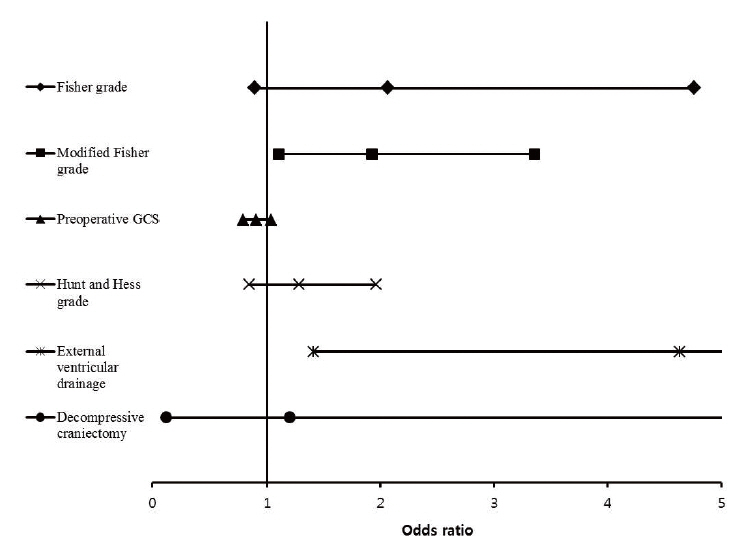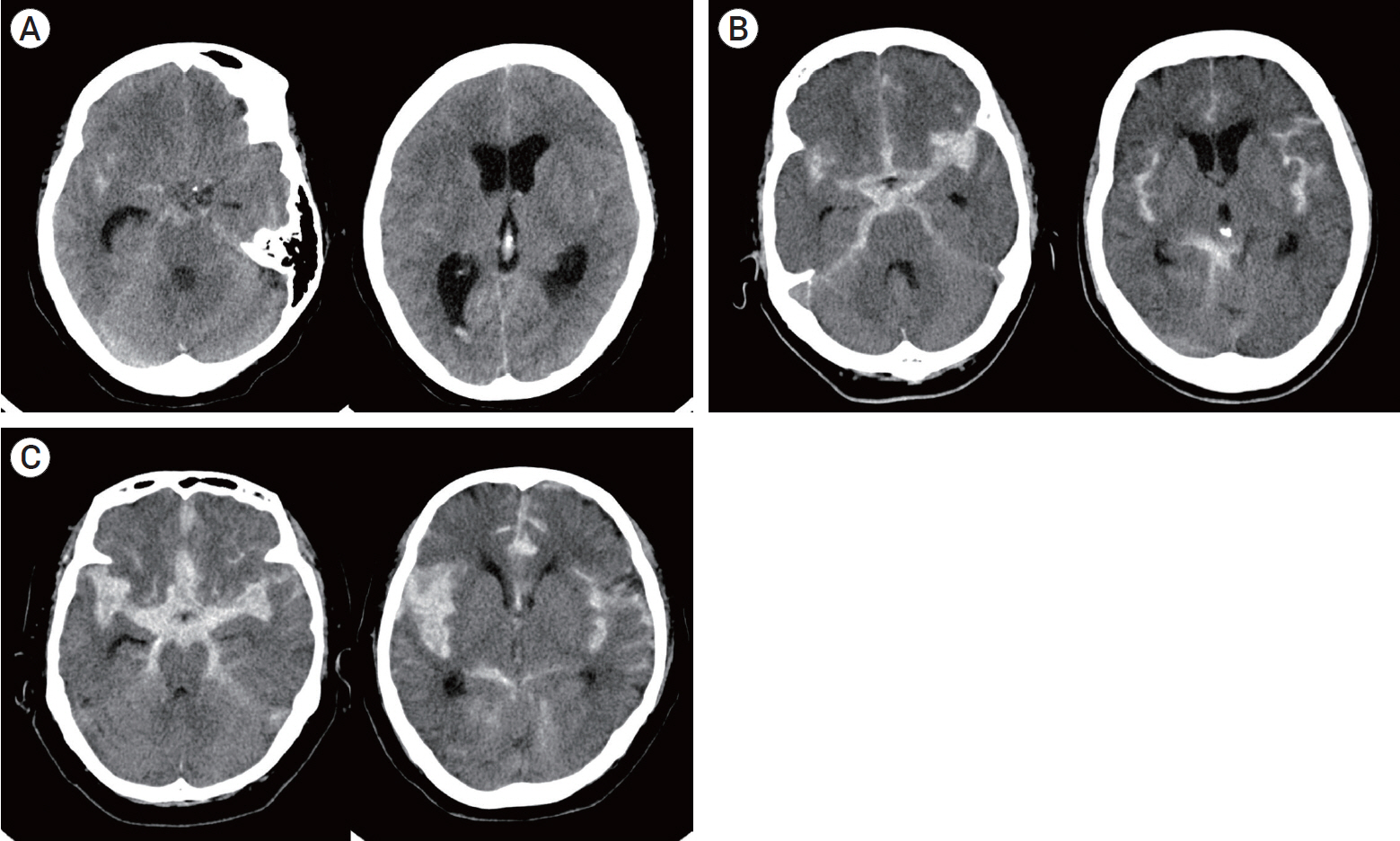J Cerebrovasc Endovasc Neurosurg.
2022 Mar;24(1):36-43. 10.7461/jcen.2021.E2021.05.006.
Factors associated with rebleeding after coil embolization in patients with aneurysmal subarachnoid hemorrhage
- Affiliations
-
- 1Department of Neurosurgery, Wonju Severance Christian Hospital, Yonsei University Wonju College of Medicine, Wonju, Korea
- KMID: 2527593
- DOI: http://doi.org/10.7461/jcen.2021.E2021.05.006
Abstract
Objective
Aneurysmal subarachnoid hemorrhage (aSAH) has a high mortality rate, and hemorrhage amounts and perioperative rebleeding importantly determines prognosis. However, despite adequate treatment, prognosis is poor in many ruptured aneurysm cases. In this study, we identified and evaluated factors related to perioperative rebleeding in patients with aSAH.
Methods
The medical and surgical records of 166 patients that underwent endovascular embolization for a ruptured cerebral aneurysm at a single institution from 2014 to 2016 were retrospectively analyzed to identify risk factors of rebleeding. All patients were examined for risk factors and evaluated for increased hemorrhage by brain computed tomography at 3 days after surgery.
Results
This series included 54 men (32.5%) and 112 women (67.5%) of mean age 58.3±14.3 years. After procedures, 26 patients (15.7%) experienced rebleeding, and 1 of these (0.6%) experienced an intraoperative aneurysmal rupture. External ventricular drainage (EVD) (odds ratio [OR] 5.389, [95% confidence interval (CI) 1.171- 24.801]) and modified Fisher grade (OR 2.037, [95% CI 1.077-3.853]) were found to be independent risk factors of rebleeding, and perioperative rebleeding was strongly associated with patient outcomes (p<0.001).
Conclusions
We concluded the rebleeding risk after aSAH is greater in patients with large hemorrhage amounts and a high pre-operative modified Fisher grade, and thus, we caution neurosurgeons should take care in such cases.
Figure
Reference
-
1. Ando T, Sakai N, Yamada H, Iwai T, Nishimura Y, Hirata T, et al. Analysis of reruptured cerebral aneurysms and the prophylactic effects of barbiturate therapy on the early stage. Neurol Res. 1989; Dec. 11(4):245–8.
Article2. Beck J, Raabe A, Szelenyi A, Berkefeld J, Gerlach R, Setzer M, et al. Sentinel headache and the risk of rebleeding after aneurysmal subarachnoid hemorrhage. Stroke. 2006; Nov. 37(11):2733–7.
Article3. Cha KC, Kim JH, Kang HI, Moon BG, Lee SJ, Kim JS. Aneurysmal rebleeding : factors associated with clinical outcome in the rebleeding patients. J Korean Neurosurg Soc. 2010; Feb. 47(2):119–23.
Article4. Choi J, Koo Y, Whang K, Cho S, Kim J. Safety of heparin loading during endovascular embolization in patients with aneurysmal subarachnoid hemorrhage. Clin Neurol Neurosurg. 2021; Feb. 201:106453.
Article5. Claassen J, Bernardini GL, Kreiter K, Bates J, Du YE, Copeland D, et al. Effect of cisternal and ventricular blood on risk of delayed cerebral ischemia after subarachnoid hemorrhage: the Fisher scale revisited. Stroke. 2001; Sep. 32(9):2012–20.
Article6. Fisher CM, Kistler JP, Davis JM. Relation of cerebral vasospasm to subarachnoid hemorrhage visualized by computerized tomographic scanning. Neurosurgery. 1980; Jan. 6(1):1–9.
Article7. Fujii Y, Takeuchi S, Sasaki O, Minakawa T, Koike T, Tanaka R. Ultra-early rebleeding in spontaneous subarachnoid hemorrhage. J Neurosurg. 1996; Jan. 84(1):35–42.
Article8. Gruber A, Dietrich W, Czech T, Richling B. Recurrent aneurysmal subarachnoid haemorrhage: bleeding pattern and incidence of posthaemorrhagic ischaemic infarction. Br J Neurosurg. 1997; Apr. 11(2):121–6.
Article9. Hellingman CA, van den Bergh WM, Beijer IS, van Dijk GW, Algra A, van Gijn J, et al. Risk of rebleeding after treatment of acute hydrocephalus in patients with aneurysmal subarachnoid hemorrhage. Stroke. 2007; Jan. 38(1):96–9.
Article10. Hilditch CA, Sonwalkar H, Wuppalapati S. Remote multifocal bleeding points producing a Sylvian subpial hematoma during endovascular coiling of an acutely ruptured cerebral aneurysm. J Neurointerv Surg. 2017; Jul. 9(7):e25.
Article11. Hillman J, von Essen C, Leszniewski W, Johansson I. Significance of “ultra-early” rebleeding in subarachnoid hemorrhage. J Neurosurg. 1988; Jun. 68(6):901–7.
Article12. Inagawa T, Kamiya K, Ogasawara H, Yano T. Rebleeding of ruptured intracranial aneurysms in the acute stage. Surg Neurol. 1987; Aug. 28(2):93–9.
Article13. Kitsuta Y, Suzuki N, Sugiyama M, Yamamoto I. Changes in level of consciousness and association with hyperglycemia as tool for predicting and preventing re-bleeding after spontaneous subarachnoid hemorrhage. Prehosp Disaster Med. 2006; May-Jun. 21(3):190–5.
Article14. Larsen CC, Astrup J. Rebleeding after aneurysmal subarachnoid hemorrhage: a literature review. World Neurosurg. 2013; Feb. 79(2):307–12.
Article15. Lovelock CE, Rinkel GJ, Rothwell PM. Time trends in outcome of subarachnoid hemorrhage: Population-based study and systematic review. Neurology. 2010; May. 74(19):1494–501.
Article16. McIver JI, Friedman JA, Wijdicks EF, Piepgras DG, Pichelmann MA, Toussaint LG, et al. Preoperative ventriculostomy and rebleeding after aneurysmal subarachnoid hemorrhage. J Neurosurg. 2002; Nov. 97(5):1042–4.
Article17. Naidech AM, Janjua N, Kreiter KT, Ostapkovich ND, Fitzsimmons BF, Parra A, et al. Predictors and impact of aneurysm rebleeding after subarachnoid hemorrhage. Arch Neurol. 2005; Mar. 62(3):410–6.
Article18. Nieuwkamp DJ, Setz LE, Algra A, Linn FH, de Rooij NK, Rinkel GJ. Changes in case fatality of aneurysmal subarachnoid haemorrhage over time, according to age, sex, and region: a meta-analysis. Lancet Neurol. 2009; Jul. 8(7):635–42.
Article19. Ohkuma H, Tsurutani H, Suzuki S. Incidence and significance of early aneurysmal rebleeding before neurosurgical or neurological management. Stroke. 2001; May. 32(5):1176–80.
Article20. Pare L, Delfino R, Leblanc R. The relationship of ventricular drainage to aneurysmal rebleeding. J Neurosurg. 1992; Mar. 76(3):422–7.
Article21. Rivero Rodríguez D, Scherle Matamoros C, Cúe LF, Miranda Hernández JL, Pernas Sánchez Y, Pérez Nellar J. Predictor’s of mortality in patients with aneurysmal subarachnoid haemorrhage and reebleding. Neurol Res Int. 2015; 2015:545407.
Article22. Ruijs AC, Dirven CM, Algra A, Beijer I, Vandertop WP, Rinkel G. The risk of rebleeding after external lumbar drainage in patients with untreated ruptured cerebral aneurysms. Acta Neurochir (Wien). 2005; Nov. 147(11):1157–61. discussion 1161.
Article23. Tang C, Zhang TS, Zhou LF. Risk factors for rebleeding of aneurysmal subarachnoid hemorrhage: a meta-analysis. PLoS One. 2014; 9(6):e99536.
Article24. Tanno Y, Homma M, Oinuma M, Kodama N, Ymamoto T. Rebleeding from ruptured intracranial aneurysms in North Eastern Province of Japan. A cooperative study. J Neurol Sci. 2007; Jul. 258(1-2):11–6.
Article25. van Donkelaar CE, Bakker NA, Veeger NJ, Uyttenboogaart M, Metzemaekers JD, Luijckx GJ, et al. Predictive factors for rebleeding after aneurysmal subarachnoid hemorrhage: rebleeding aneurysmal subarachnoid hemorrhage Study. Stroke. 2015; Aug. 46(8):2100–6.
Article26. Wu TC, Tsui YK, Chen TY, Lin CJ, Wu TC, Tzeng WS. Rebleeding of aneurysmal subarachnoid hemorrhage in computed tomography angiography: risk factor, rebleeding pattern, and outcome analysis. J Comput Assist Tomogr. 2012; Jan-Feb. 36(1):103–8.
- Full Text Links
- Actions
-
Cited
- CITED
-
- Close
- Share
- Similar articles
-
- Rebleeding of Ruptured Intracranial Aneurysms in the Immediate Postoperative Period after Coil Embolization
- Effect on Shunt-dependent Hydrocephalus after Coil Embolization for Aneurysmal Subarachnoid Hemorrhage
- Effects of Antiplatelet Agents on Cerebral Vasospasm and Delayed Cerebral Ischemia in Aneurysmal Subarachnoid Hemorrhage Patients Treated with Coil Embolization
- A Case of Turner Syndrome Presenting as Aneurysmal Subarachnoid Hemorrhage
- Management of The Poor Grade Aneurysm Patient



